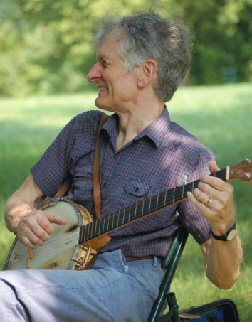
Mike Seeger
The Seeger family tree for the last century has soaked its roots in music and sprouted no fewer than three major performers in the folk world. The paterfamilias was composer/ethnomusicologist Charles Seeger (1886-1979), whose first marriage produced the iconic
musician and activist Pete Seeger and two other sons. His second wife, composer/arranger/musicologist Ruth Crawford Seeger (1901-53), the first woman to win a Guggenheim Fellowship for Music, gave birth to Mike, Peggy, Barbara, and Penny, who later married John Cohen, Mike’s bandmate in the New Lost City Ramblers.
By the time the Seegers moved from New York to suburban Maryland in 1936 after Charles was appointed to the federal New Deal administration, they were already acquainted with song collectors John and Alan Lomax, whom they’d met through left-wing political organizations. With Ruth hired to transcribe the Lomaxes’ field recordings of rural American music for the Library of Congress, little Mike (1933 - 2009) and his younger sisters were imprinted with those songs through repeated listenings and Saturday night singalongs.
Mike taught himself various stringed instruments in his late teens and soon teamed with already adept instrumentalist Peggy (born in 1935) in performing at local square dances. Soon Mike was traveling the Washington, D.C., area looking for traditional musicians to record and “new” old songs to learn. One of his major discoveries came about by coincidence in the late ’40s when he learned that the Seegers’ Southern-born housekeeper, Elizabeth “Libba” Cotten, was a singer, songwriter and guitarist who had put music aside for the last 25 years. Mike taped her singing and playing and produced her first album in 1957, containing her classic “Freight Train.”
Tapped by Folkways Records owner Moe Asch to record and assemble an album of banjo players, Mike made his own recording debut on the resultant 1956 LP, American Banjo, Three Finger & Scruggs Style, the first of many documentary albums he made as a “sort of aural historian,” capturing previously obscure American musicians and spreading their songs to new generations of players and listeners.
In 1958, Mike and like-minded musicians John Cohen and Tom Paley (later replaced by Tracy Schwarz) formed The New Lost City Ramblers, a revered group that specialized in obscure rural and working class music of the 1920s through early ’40s. Drawing their repertoire from Library of Congress field recordings and old 78rpm records, the Ramblers recorded a remarkable 12 albums between 1958 and 1962 and continued to perform and record periodically through 2009.
Mike’s first solo album, Oldtime Country Music (1962), was followed by more than 40 other albums of his own music, solo and with others, and he toured internationally with the Ramblers and on his own. “He played . . . the full index of old-time styles,” wrote Bob Dylan in his autobiography, and “he played these songs as good as it was possible to play them. What I had to work at, Mike already had in his genes.” “His impact on the shape and perception of American music is truly incalculable,” eulogized England’s Independent.
Mike’s work earned him the National Endowment of the Arts’ highest honor, a National Heritage Fellowship, and the Ralph J. Gleason Lifetime Achievement Award from the Rex Foundation, established by the Grateful Dead, as “one of our great musical and cultural resources.”
At the time of his death, Mike was working on a documentary of what he saw as a “revival/survival” of specifically Southern old-time music in progress, interviewing and recording 20 banjo players. His widow, Alexia Smith, is working to complete the project.
|


